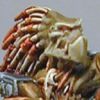| Author |
Message |
 |
|
|
 |
|
Advert
|
Forum adverts like this one are shown to any user who is not logged in. Join us by filling out a tiny 3 field form and you will get your own, free, dakka user account which gives a good range of benefits to you:
- No adverts like this in the forums anymore.
- Times and dates in your local timezone.
- Full tracking of what you have read so you can skip to your first unread post, easily see what has changed since you last logged in, and easily see what is new at a glance.
- Email notifications for threads you want to watch closely.
- Being a part of the oldest wargaming community on the net.
If you are already a member then feel free to login now. |
|
 |
![[Post New]](/s/i/i.gif) 2012/11/11 11:15:51
Subject: Using oil paints
|
 |

Slippery Scout Biker
|
Hello,
After doing some wet blending with standard gw colours recently I heard that oil paints are supposed to be much easier to do that sort of thing with. I wet blend power weapon effects and paint lightning over the top, so the idea is to prime the model, then wet blend some blue power weapon glow effects using oil and once dry (I heard that can take up to a week) paint the lightning on using acryllics. Might then put matt varnish over the lot to keep it in place.
I have never worked with oils before so wondered if anyone has any experience with doing anything similar. Any tips are appreciated, but specifically I wondered if there are any problems with using chaos black as a base coat/primer (i.e. painting oils onto acryllics) or with painting acryllics onto a layer of oils when I do the lightning.
Thanks for your collected wisdom in advance.
|
There is no innocence. Only degrees of guilt. |
|
|
 |
 |
![[Post New]](/s/i/i.gif) 2012/11/11 11:40:35
Subject: Using oil paints
|
 |

Liche Priest Hierophant
|
Wow there horsey!
Oil is terrible rubbish to work with from a wargamer prespective.
It is thick, glozzy and it does not disolve in water. So goodbye to details and you will be sitting thinning it with terpentine.
A better idea would be to add some retarder to your acrylic paint. It is a solvent that makes it more like oilpaint. While it might be nice on the sword, I experienced with it one some space marines and the details just disapeared. I think you need a large surface to get it right (a tank, or a swordblade perhaps) but even then I am more confortable using my acrylic tecniques.
|
|
|
|
 |
 |
![[Post New]](/s/i/i.gif) 2012/11/11 11:46:48
Subject: Using oil paints
|
 |

Oberstleutnant
|
Check this video, shows how much easier wet blending can be withoils.
|
|
This message was edited 1 time. Last update was at 2012/11/11 11:47:21
|
|
|
 |
 |
![[Post New]](/s/i/i.gif) 2012/11/11 15:10:20
Subject: Using oil paints
|
 |

Colonel
This Is Where the Fish Lives
|
 Niiai wrote: Niiai wrote:Wow there horsey!
Oil is terrible rubbish to work with from a wargamer prespective.
It is thick, glozzy and it does not disolve in water. So goodbye to details and you will be sitting thinning it with terpentine.
A better idea would be to add some retarder to your acrylic paint. It is a solvent that makes it more like oilpaint. While it might be nice on the sword, I experienced with it one some space marines and the details just disapeared. I think you need a large surface to get it right (a tank, or a swordblade perhaps) but even then I am more confortable using my acrylic tecniques.
Terrible rubbish is a bit of stretch, especially considering some of the finest model painters in the world make extensive use of oil paints. I would also like to point out that there are water-mixable oil paints out there that work great for wet blending. I would recommend to anyone serious about painting to invest in a couple of tubes of oil paints because they are a very versatile medium. Admittedly though, the best best use most model painters have for them is making washes and using them for weathering, much like military modelers do. In that regard they are far superior to acrylic paints.
|
 d-usa wrote: d-usa wrote:"When the Internet sends its people, they're not sending their best. They're not sending you. They're not sending you. They're sending posters that have lots of problems, and they're bringing those problems with us. They're bringing strawmen. They're bringing spam. They're trolls. And some, I assume, are good people."
|
|
|
 |
 |
![[Post New]](/s/i/i.gif) 2012/11/11 17:30:06
Subject: Using oil paints
|
 |

Slippery Scout Biker
|
Like I said I'm not planning to cover the whole model in the stuff but rather paint power weapon effects with it. The most detailed area that will be covered in it will be the fingers of a power fist and maybe a storm shield. The rest are axe and sword blades.
The question therefore remains: Are there any issues with using oil on top of acryllics and vice versa?
|
There is no innocence. Only degrees of guilt. |
|
|
 |
 |
![[Post New]](/s/i/i.gif) 2012/11/11 18:17:01
Subject: Using oil paints
|
 |

Longtime Dakkanaut
|
Other than overcoming the utter confusion and lack of understanding you find...
The biggest thing that you will want to do is to make sure the previous layer is fully cured before you switch paints.
If you use water based paints like acrylics over an oil based paint before it has had a chance to cure completely the residual solvent can negatively impact the adhesion of the acrylic paints. The same goes in the other direction as the oils over water based paints can prevent the water from completely being released or worse, act as a paint stripper and cause the water based paint so slough off.
I usually give it a good 48 hours between types of paint just for simplicity - though it will depend on the type of paints, the thickness of the layers and the amount of solvent used (either water or turps type solvents).
Keep in mind that the very smoothly flowing enamel paints sold for model kits is an oil paint in the same manner that artist's tube paints are. Consistency and some additional additives make them seem different, but in practice you can thin down tube oils enough to spray them out of an airbrush if you want to (and you will often see model builders do as much for weathering on vehicles and skin tones on larger figures).
If you are looking to pick them up though, be sure to shop around a bit. I like to use model enamels for my oil painting techniques though I also use tube paints from MIG and a couple of artist's brands. Some artist's paints though have a course grain to them though on purpose. They are intended to imitate the look and feel of paints used 100+ years ago, so you can sometimes see the grains of pigment with your naked eye. Others use the same near liquid pigments that are used in modern paints - including the majority of hobby paints.
Also - separate brushes. You don't want to ruin a high dollar kolinski sable brush by using it with oil paints. The solvents which are used to thin them and the binder which makes up the bulk of them will turn a great brush for water based paints into a bit of rubbish fairly quickly. You can clean and condition a whole lot to prevent it from happening, but I prefer just to have a handful of brushes which are used specifically for my oil paints. I find hogs hair (China) brushes work well for oil - though various synthetic bristles which are wanting for acrylics work great too (Golden Talkon being the most popular of them).
I guess I should also mention that you might want to keep in mind things like gloss coats. Compared to acrylics, oils will find every single last tiny bit of texture. If you are weathering a vehicle, this can be helpful over top a matte surface (which is really just a whole lot of tiny texture). However, if you are attempting to get a smooth blending for skin tones or various fade effects, the texture can ruin the effect. So - you apply the oil over a gloss coat in those cases. You can either hit the whole model with gloss (either a clear coat like future or a gloss primer if you are doing the base coat).
And I guess just for sake of completeness you should be aware of the issue of the solvents. Certain solvents for thinning oil paints are strong - sometimes they refer to them as hot. When you are painting over plastic models - if you choose to use a hot solvent, it can actually melt the plastic. Most of the common solvents though are not a significant problem though, and once you have a protective layer of paint (either an acrylic base coat or a gloss primer) you can go forward without too much of a worry.
|
|
|
 |
 |
![[Post New]](/s/i/i.gif) 2012/11/11 18:46:01
Subject: Re:Using oil paints
|
 |

Decrepit Dakkanaut
|
Oil colours are established for military modelling artists.
For wargamers, they have two big disadvantages:
1.) You need strong chemicals for thinning, brush cleaning etc and extra brushes.
2.) Oil paints take ages to dry. Good for people working ages on specific details, but bad if you want to play with the miniatures.
|
|
|
|
 |
 |
![[Post New]](/s/i/i.gif) 2012/11/11 18:50:01
Subject: Using oil paints
|
 |

Navigator
|
One thing that some military modelers do is coat their model with future floor finish when switching paints. The future helps protect the acrylic paints from the paint thinners you would use with the oils, particularly when using them for washes and dot filters.
|
|
|
 |
 |
![[Post New]](/s/i/i.gif) 2012/11/11 19:53:09
Subject: Re:Using oil paints
|
 |

Longtime Dakkanaut
|
 Kroothawk wrote: Kroothawk wrote:2.) Oil paints take ages to dry. Good for people working ages on specific details, but bad if you want to play with the miniatures.
Keep in mind - the speed at which oils dry is directly related to their thickness. If you use thin coats, they can be fully dried within a few hours time with modern oils. Historical oil paints (including some reproduction artist's oils) can take years to fully cure though. This understanding of artist's oils compared to modern oils - especially modern hobby oils leads to a bit of confusion and unnecessary.
The modern paints generally have high levels of alkyd resins which can properly cure in an hour or so on their own. They are mixed with traditional oil resins and other chemicals in order to provide a behavior which is more in line with historical artist's oils. Additives like liquin can increase the drying time even more as well as the use of certain solvents which have the effect of accelerating the oxidization process.
|
|
|
 |
 |
![[Post New]](/s/i/i.gif) 2012/11/11 21:17:44
Subject: Using oil paints
|
 |

Slippery Scout Biker
|
Thanks for the advice guys, particularly Sean. Some really helpful stuff there. I shall give this a go on a powersword first, since I have wet blended quite a few of those with acryllics already so know exactly what effect I'm looking for, and it's a big flat surface.
Drying time really isn't an issue for me as long as I'm not looking at weeks for each coat.
Do you think it's worth doing a coat of vallejo matt varnish (my favorite brush on matt varnish) on top of the dried oil before putting on the acryllic lightning on top, or is that overkill since I will be covering the whole thing in the stuff once it's finished anyway?
|
There is no innocence. Only degrees of guilt. |
|
|
 |
 |
![[Post New]](/s/i/i.gif) 2012/11/12 13:49:15
Subject: Using oil paints
|
 |

Longtime Dakkanaut
|
Normally I don't cover my oil paints before I put acrylics on top of them. Thin coats and a suitable amount of time between the oil and the acrylic paints should be fine.
On the lightning - you might consider actually using oils as well for that as opposed to acrylics. One of the neat things with oils is that they go through a variety of workable states before they are dry (as opposed to acrylics which are either wet or not).
If you use a good detail brush you can rough out the bolt pattern on the blade fairly easily, then once that has has a chance to sort of half dry, you grab a clean brush and get a bit of your solvent on it. Use that brush to pull away from the lightning bolts which you made in order to give it a glow effect.
It is similar to the concept that you see used to create rust streaks when weathering vehicles (dab of paint around a rivet, wet brush to draw it down from the rivet).
As with most things - you will probably want to practice on something which is less important to get a handle for how the paints behave when trying new techniques. I buy up boxes of match box type cars for that. They have a lot of different shapes and sizes to find a specific part which you can try your idea on, are dirt cheap and you can easily strip them when you want a clean slate to work with.
|
|
|
 |
 |
|
|